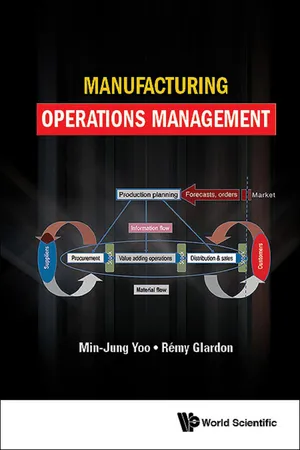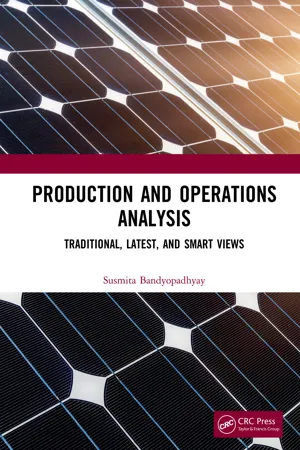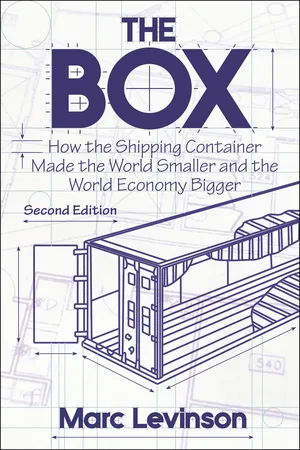Geography
Just in Time Delivery
Just in Time Delivery is a strategy used in supply chain management to minimize inventory costs by receiving goods only as they are needed in the production process. This approach reduces the need for large storage facilities and excess inventory, leading to cost savings and more efficient use of resources.
Written by Perlego with AI-assistance
Related key terms
Related key terms
1 of 4
Related key terms
1 of 3
3 Key excerpts on "Just in Time Delivery"
- eBook - ePub
- Min-Jung Yoo, Rémy Glardon(Authors)
- 2018(Publication Date)
- WSPC (EUROPE)(Publisher)
•Increase of service quality (i.e. reliability of delivery).These trends are primarily due to the global market and competition that companies have to deal with, while always putting forward their distinguishing advantages. The consequences of this business evolution on production & operations management are that:•Rationalisation methods adapted to high volumes (heavy automation) become inappropriate; •Planning methods based on medium term forecasts become inapplicable. Therefore, it is preferable that management method and tools are adapted to such a situation, in particular: •Improve the delivery flexibility without increasing tied-up capital;•Satisfy market demand as quickly as possible, i.e. Just-In-Time;•Reduce the costs, particularly the costs that do not contribute to adding value, i.e. the hidden factory.This is what the Just-in-Time approach tries to do. Several definitions of Just-in-Time, JIT, can be found in the abundant literature on the subject. Among many definitions, within the scope of this book, we define it as “A production and logistics strategy based on an efficient management of material and information flows, with the purpose of responding to market requirements with maximum efficiency”.The most well-known principle of JIT concerns produce only what will be sold, at the right moment, with the required quality and in exact quantity. It is noted that JIT can be seen and has been used as a: •Global production philosophy; •Strategy for production and logistics organisation; •Management method; •Group of management, planning and control techniques.As stated above, JIT calls for simplification and transparency. It promotes also continuous improvement and the resolution of inefficiencies and malfunctioning instead of creating buffers in order to cover them. This is an important philosophical element, which often corresponds to a cultural attitude and a major change.JIT advocates a permanent fight against any activity and cost that does not add value for the customer. Subsequently, it calls for the elimination, or reducing as much as possible all administrative tasks, centralised hierarchical controls. Instead of such inefficiencies, it looks for simplification and the delegation of responsibility to the shop-floor. This ballast of non-value-adding activities is sometimes called the hidden factory - eBook - ePub
Production and Operations Analysis
Traditional, Latest, and Smart Views
- Susmita Bandyopadhyay(Author)
- 2019(Publication Date)
- CRC Press(Publisher)
Section 10.2.2 . The various implementation measures as discussed are red tagging, use of signboards, outlining, use of Andon, use of Kanban, use of buzzers.Till now, a significant number of aspects related to the JIT manufacturing concept have been discussed. The next section now discusses the various important aspects of JIT logistics, in brief.10.7.1 Just-in-Time Logistics
The American Council of Logistics Management defines logistics as “the process of planning, implementing and controlling the efficient, cost effective flow and storage of raw materials, in-process inventory, finished goods, and related information from point of origin to point of consumption for the purpose of conforming to customers’ requirements.” Philip Kotler defines logistics as “planning, implementing, and controlling the physical flows of materials and finished goods from point of origin to point of use to meet the customer’s need at a profit.” The basic objectives of logistics activity can be delineated through the following points.• Minimization of inventory• Minimization of costs related to logistics• Reliable and consistent delivery of performance• Minimize the damage to the products• Quicker and faster response to the customersHowever, from the point of view of JIT, the goal of logistic is to deliver to customer, the right product in right condition in right quantity, to the right customer at the right place at the right time, at the right price - eBook - ePub
The Box
How the Shipping Container Made the World Smaller and the World Economy Bigger - Second Edition with a new chapter by the author
- Marc Levinson(Author)
- 2016(Publication Date)
- Princeton University Press(Publisher)
2The wonders of just-in-time were unmentioned outside Japan before 1981. In 1984, as Toyota agreed to assemble cars at a General Motors plant in California, U.S. business publications ran thirty-four articles on justin-time. In 1986, there were eighty-one, and companies around the world were seeking to emulate Toyota’s high-profile success. In the United States, two-fifths of the Fortune 500 manufacturers had started just-in-time programs by 1987. Overwhelmingly, these companies found that just-in-time required them to deal with transportation in a very different way. No more would manufacturers offer a load or two to some truck line’s hungry salesman. Now, they wanted large-scale relationships with a much smaller number of carriers able to meet stringent requirements for on-time delivery. Customers demanded written contracts that imposed penalties for delays. Even shipments from another continent were expected to arrive on schedule. Railroads, ship lines, and truck lines with large route networks and sophisticated cargo-tracking systems had the edge.3Before the 1980s, “logistics” was a military term. By 1985, logistics management—the task of scheduling production, storage, transportation, and delivery—had become a routine business function, and not just for manufacturers. Retailers discovered that they could manage their own supply chains, cutting out the wholesalers that had stood between manufacturers and consumers. With modern communications and container shipping, the retailer could design its own shirts and transmit the designs to a factory in Thailand, which used local labor to combine Chinese fabric made from American cotton, Malaysian buttons made from Taiwanese plastics, Japanese zippers, and decorations embroidered in Indonesia. The finished order, loaded into a 40-foot container, would be delivered in less than a month to a distribution center in Tennessee or a hypermarché
Index pages curate the most relevant extracts from our library of academic textbooks. They’ve been created using an in-house natural language model (NLM), each adding context and meaning to key research topics.
Explore more topic indexes
Explore more topic indexes
1 of 6
Explore more topic indexes
1 of 4


